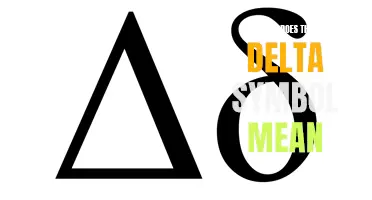
The symbol of Tao, also known as the Taijitu or Yin Yang, is steeped in profound meaning and has captivated the minds of philosophers, scholars, and artists for centuries. Representing the fundamental balance and interplay of opposing forces in the world, the Tao symbol offers a glimpse into the complex dynamics of existence and the interconnectedness of all things. From the ancient Chinese philosophy of Taoism to modern-day interpretations of harmony and duality, delving into the depths of the Tao symbol unveils a rich tapestry of wisdom and understanding. Join me on a journey to uncover the captivating symbolism and profound meanings behind the enigmatic Tao symbol.
What You'll Learn

What is the symbolism behind the Tao symbol?
The Tao symbol, also known as the Taijitu, is a fundamental concept in Taoism that represents the harmonious balance between opposites. It is often depicted as a circle divided into two halves, one black and one white, with a smaller circle of the opposite color within each half. These halves are interwoven in a way that creates a swirling pattern, symbolizing the continuous cycle of opposing forces.
The Tao symbol is derived from the philosophy of Taoism, which emphasizes the importance of living in harmony with the natural world and embracing the duality of existence. According to Taoist teachings, there are two fundamental forces that shape the universe: Yin and Yang. Yin represents the feminine, passive, and dark aspects, while Yang represents the masculine, active, and light aspects.
The black half of the Tao symbol represents Yin, while the white half represents Yang. The smaller circle of each color within its opposite half indicates that Yin and Yang are interconnected and contain a seed of their opposite within themselves. This reflects the Taoist belief that everything in the universe contains both Yin and Yang energies, and that they are in a perpetual state of transformation.
The swirling pattern formed by the interwoven halves of the Tao symbol represents the continuous flow and interdependence of Yin and Yang. It symbolizes the dynamic nature of existence, where opposing forces are not seen as conflicting, but rather as complementary and necessary for maintaining balance.
The symbolism behind the Tao symbol extends beyond the concept of duality. It also signifies the notion of unity and interconnectedness. Taoism teaches that all things are interconnected and part of a larger whole, known as the Tao. The Tao is often described as the underlying principle that governs the universe and guides all natural processes.
The Tao symbol serves as a visual representation of this interconnectedness, showing that everything is interconnected and dependent on each other. It reminds individuals to embrace the inherent contradictions and opposing forces within themselves and the world around them.
In addition to its philosophical symbolism, the Tao symbol is also associated with practical applications in various disciplines. In martial arts, for example, the concept of Yin and Yang is utilized to achieve balance and harmony in movement. In traditional Chinese medicine, Yin and Yang are used to understand the dynamic balance of the body's energy and restore health.
Overall, the symbolism of the Tao symbol is multifaceted, representing the harmony of opposites, the interconnectedness of all things, and the dynamic nature of existence. It serves as a reminder to embrace the contradictions and interdependencies that define life and to seek balance and harmony in all aspects of our being.
Decoding the Waze: A Comprehensive Guide to Understanding Waze Symbol Meanings
You may want to see also

How does the Tao symbol represent balance and harmony?
The Tao symbol, also known as the Yin and Yang symbol, represents balance and harmony in several ways. It is an ancient Chinese symbol that encapsulates the concept of duality and the interconnectedness of all things in the universe. The symbol consists of a circle divided into two halves, one black and one white, with a small dot of the opposite color in each half. The black side is called Yin, while the white side is called Yang.
The Yin and Yang symbol represents balance and harmony by emphasizing the complementary nature of opposites. Yin and Yang are contrasting but complementary forces that exist in everything. Yin represents qualities such as darkness, passivity, femininity, and introspection, while Yang represents qualities such as light, activity, masculinity, and extroversion. The symbol demonstrates that these opposing forces are interconnected and interdependent, and that they rely on each other for existence.
The Tao symbol also represents balance and harmony through its circular shape. The circle is a symbol of wholeness and completeness, and it suggests that there is a continuous flow and movement between Yin and Yang. Just as day turns into night and vice versa, life is a constant cycle of change and transformation. The Tao symbol reminds us that balance and harmony can only be achieved by embracing and accepting these natural cycles instead of resisting them.
Furthermore, the small dots of the opposite color in each half of the symbol also highlight the idea of balance and harmony. They indicate that within Yin, there is always a seed of Yang, and within Yang, there is always a seed of Yin. This concept suggests that nothing is purely Yin or purely Yang, and that there is always a potential for change and transformation. It is this interplay between Yin and Yang that allows for the continuous flow and harmony in the universe.
The Tao symbol also emphasizes the importance of finding harmony between opposites within ourselves and in our daily lives. It encourages us to seek balance between work and rest, action and reflection, and between all other dualities that exist in our lives. By embracing both Yin and Yang aspects of our being, we can achieve a state of wholeness and harmony. This is why the Tao symbol has become a widely recognized symbol for balance and harmony in various aspects of life, including health, relationships, and personal growth.
In conclusion, the Tao symbol represents balance and harmony in multiple ways. Its depiction of Yin and Yang as complementary forces demonstrates the interconnectedness and interdependence of opposites. The circular shape of the symbol symbolizes the continuous flow and movement between Yin and Yang. The small dots within each half highlight the potential for change and transformation. Ultimately, the Tao symbol serves as a reminder to seek balance and harmony within ourselves and in our daily lives.
Decoding the Meaning of a Sex Symbol: Unraveling the Secrets Behind Society's Attraction
You may want to see also

What does the yin and yang within the Tao symbol represent?
The concept of yin and yang is deeply rooted in Taoist philosophy and is symbolized by the yin-yang symbol, also known as the Taijitu. This symbol consists of two interlocking shapes, one black and one white, forming a perfect circle. Yin and yang represent the dualistic nature of the universe and the harmony and balance between opposing forces.
Yin and yang are complementary and interconnected qualities that exist in everything, and they cannot exist without each other. The black side of the symbol represents yin, which signifies qualities such as darkness, femininity, passivity, softness, coldness, and potential. The white side represents yang, representing qualities such as light, masculinity, activity, hardness, warmth, and creativity.
The yin-yang symbolizes how these opposing forces are interconnected and constantly changing into each other. The small circle within the yin-yang represents the idea that each aspect contains the seed of the other, illustrating the continuous interplay and harmony between yin and yang.
Yin and yang can be observed in various aspects of life. For example, night (yin) turns into day (yang) and vice versa, winter (yin) transforms into summer (yang), and quietness (yin) gives rise to sound (yang). This continual interaction and balance between opposing forces are believed to be fundamental to the functioning of the universe.
The symbol also suggests that everything in the universe contains both yin and yang aspects. For example, within masculinity (yang), there is a seed of femininity (yin), and within femininity, there is a seed of masculinity. The symbol emphasizes the importance of balance, as an excess of either yin or yang can lead to imbalance and disharmony.
Furthermore, the yin-yang symbol represents the belief that yin and yang are not absolute qualities but rather exist on a continuum. This means that there can be varying degrees of yin and yang within different phenomena. For example, a sunny day may be more yang than a cloudy day, but even within the sunniest day, there is still some darkness present.
The concept of yin and yang extends beyond the physical realm and encompasses more abstract ideas such as emotions and actions. For example, love and hate, joy and sorrow, and action and rest can all be seen as different expressions of yin and yang. Taoist philosophy encourages individuals to find balance within themselves and align their actions and emotions with the harmonious interplay of yin and yang.
In summary, the yin and yang within the Tao symbol represent the dualistic nature of the universe and the interconnectedness of opposing forces. The symbol serves as a reminder of the importance of balance and harmony in all aspects of life. By recognizing and embracing the interplay of yin and yang, individuals can strive for a state of equilibrium and align themselves with the natural flow of the universe.
Understanding Turkish Symbols and their Meanings
You may want to see also

How does the Tao symbol relate to the concept of duality?
The Tao symbol, also known as the Taijitu symbol, is a representation of the concept of duality in Taoism. It consists of a circle divided into two halves, one black and one white, with a smaller circle of the opposite color in each half. The black half represents Yin, which is associated with femininity, darkness, passivity, and the moon. The white half represents Yang, which is associated with masculinity, light, activity, and the sun.
At first glance, the Tao symbol may seem to suggest a clear separation between Yin and Yang, but upon closer inspection, one can see that each half contains a small circle of the opposite color. This implies that within Yin, there is always a trace of Yang, and within Yang, there is always a trace of Yin. This signifies that the two opposing forces are interconnected and interdependent. It represents the idea that everything in the universe contains both Yin and Yang aspects, and that they exist in a constant state of flux, complementing and balancing each other.
The concept of duality is central to Taoism, and the Tao symbol serves as a visual representation of this principle. It symbolizes the essential harmony and balance that exists in nature and the universe. According to Taoist philosophy, everything in the world is a manifestation of the dynamic interplay between Yin and Yang. It is believed that the interaction of these opposing forces gives rise to all phenomena and experiences.
In Taoism, duality is not seen as a conflict or struggle between opposites but rather as a harmonious dance of complementary forces. Yin and Yang are not seen as opposing or competing entities, but as complementary and interdependent aspects of a whole. They are like the two sides of a coin or the two ends of a spectrum – they cannot exist without each other.
The Tao symbol also suggests that there is a constant flow and transformation between Yin and Yang. The small circles within each half indicate that Yin can transform into Yang, and Yang can transform into Yin. This represents the ever-changing nature of life and the universe. Just as day turns into night and winter turns into spring, the Tao symbol reminds us that everything is in a state of constant flux and transformation.
In conclusion, the Tao symbol represents the concept of duality in Taoism. It visualizes the interplay and interdependence of Yin and Yang, the two opposing forces in the universe. Rather than being static or in conflict, Yin and Yang are seen as dynamic and complementary aspects of a whole. The Tao symbol serves as a reminder of the harmonious nature of existence and the constant flow and transformation between opposing forces.
Exploring the Intricate Meanings Behind Ancient Symbols
You may want to see also

Can you explain the significance of the circular shape of the Tao symbol?
The Tao symbol, also known as the yin yang symbol, is a circular shape that holds significant meaning in Taoism. This ancient Chinese philosophy is based on the balance and interplay of opposing forces, and the circular shape of the Tao symbol represents the cyclical nature of life and the universe.
The circular shape of the Tao symbol represents the infinite and ever-changing nature of reality. It symbolizes the continuous flow of energy and the interconnectedness of all things. Just as the Earth orbits the sun in a circular motion, everything in the universe is in a constant state of motion and change.
The Tao symbol is divided into two halves, one black and one white, with a smaller circle of the opposite color within each half. The black side represents yin, which is associated with qualities such as darkness, femininity, and passivity. The white side represents yang, which is associated with qualities such as light, masculinity, and activity.
These contrasting halves show that everything in the universe contains some aspect of its opposite. For example, even in the darkest of times, there is always a glimmer of hope, just as a white dot is present in the black half of the Tao symbol. Likewise, in the brightest moments, there is always a hint of darkness, symbolized by the black dot in the white half of the symbol.
The smaller circles within each half also represent the idea that yin and yang are not static but constantly changing and transforming into one another. This concept is known as the principle of mutual arising. It suggests that nothing can exist without its opposite and that balance can only be achieved by embracing both sides of the duality.
The circular shape of the Tao symbol also reflects the Taoist belief in the cyclical nature of life. Taoism teaches that everything goes through cycles of growth, decay, and renewal. Just as the seasons change in a never-ending cycle, so too do the ups and downs of life. This circular motion reminds us to embrace the inevitable changes and fluctuations in life and find harmony within them.
In summary, the circular shape of the Tao symbol represents the infinite and ever-changing nature of reality. It symbolizes the continuous flow of energy and the interconnectedness of all things. The contrasting halves and smaller circles within the symbol reflect the balance and interplay of opposing forces. Ultimately, the circular shape serves as a reminder to embrace the cyclical nature of life and find harmony within its constant changes.
Exploring the Rich Cultural Heritage: African Symbols and Their Powerful Meanings
You may want to see also
Frequently asked questions
The Tao symbol, also known as the Taijitu, represents the Taoist concept of yin and yang. It is a visual representation of the duality and interconnectedness of all things. The black side represents yin, which symbolizes darkness, femininity, passivity, and earth. The white side represents yang, representing light, masculinity, activity, and heaven. The circle in the middle represents the harmony and balance between these opposing forces.
While the Tao symbol and the yin-yang symbol are often used interchangeably, there is a slight difference in their meanings. The yin-yang symbol focuses more on the contrast between yin and yang, while the Tao symbol emphasizes the harmony and balance that can be achieved when the two forces coexist and complement each other. The Tao symbol also incorporates the circle in the middle, which represents the ultimate unity and wholeness of the Tao.
The Tao symbol serves as a reminder to seek balance and harmony in all aspects of life. It teaches us that everything is interconnected, and that we should strive to find equilibrium between opposing forces. Whether it's balancing work and personal life, embracing both the light and dark aspects of our personalities, or recognizing the importance of rest and action, the Tao symbol can guide us in living a more harmonious and fulfilling life.
Yes, the Tao symbol is deeply rooted in Taoist philosophy and spirituality. It represents the Tao, which is the underlying principle of the universe and the source of all things. It symbolizes the idea of non-duality and the interconnectedness of all beings. By contemplating and meditating on the Tao symbol, individuals can deepen their understanding of the Taoist teachings and cultivate a sense of spiritual harmony and enlightenment.
While the Tao symbol is primarily associated with Taoism, it has also been adopted and used in other spiritual and philosophical traditions. It has become a popular symbol in Western New Age spirituality, as well as in various forms of holistic healing and alternative therapies. The symbol's universal and inclusive nature makes it adaptable to various belief systems, as it represents the fundamental principles of balance, harmony, and interconnectedness that are applicable to all aspects of life.







